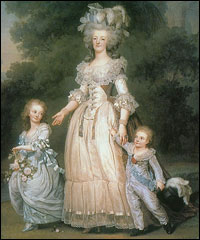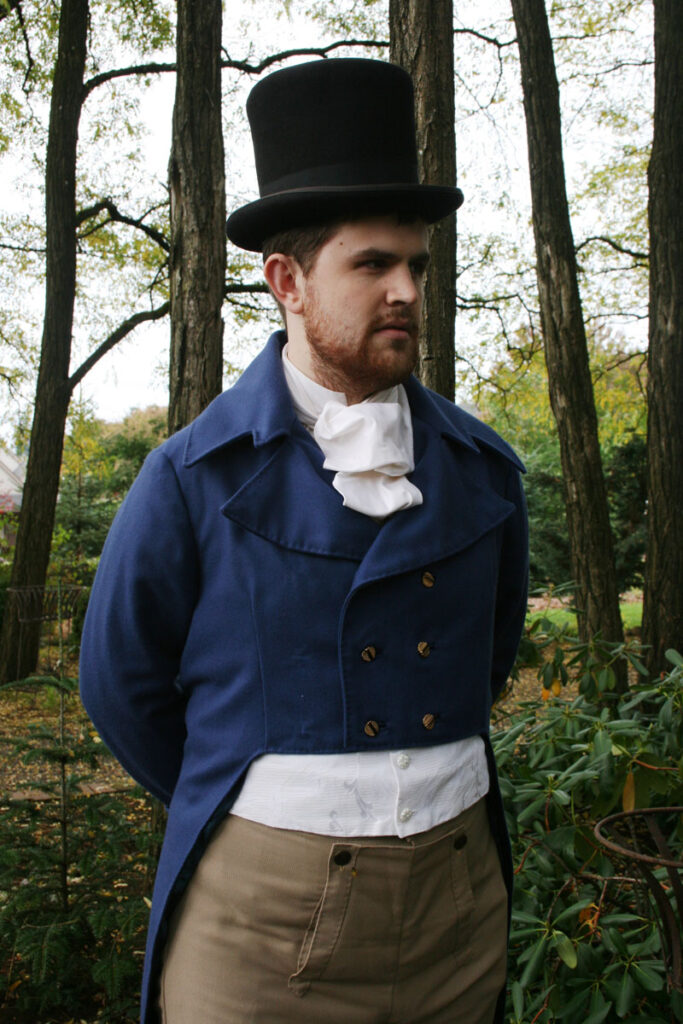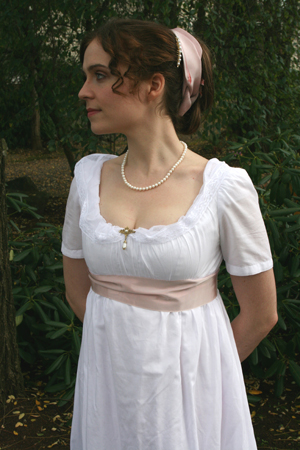The earliest styles that we make celebrate the Colonial era, the New Nation, and the Early Federal period in American history. From the Revolutionary War in America through the end of the Georgian epoch, we make clothing suitable for Jane Austen enthusiasts and Early American reenactors.
Late 18th Century Style
From 1776 to about 1800, fashions were still very traditional and formal in shape and style.
The dress at the far right, an elegant Robe à la Turque, is in the style of the transitional mid-1780’s. Of red silk taffeta, it is worn with a white cotton underdress and lace cuffs, and ribbon sash. Angela’s large hair and feather headress show a lovely evening look of the period.
This style of dress, in a much more extravagant version, is worn by Marie Antoinette in this rendition (below) of a 1785 Wertmuller painting.



Early 19th Century Styles
At the dawn of the 19th century, fashions were simple. Women’s dresses were generally made of fine white cotton fabrics, with a high waistline, simple trims, and low necklines. As the century progressed, color was added in the dress fabrics, jackets, shawls or overdresses.
Daywear
This simple white cotton day dress (left) is typical of the very early 1800’s, with straight sleeves and empire waist. After the structured 1790’s, the style shifted very dramatically to the plain white cotton “muslins” of Jane Austen’s heroines.
Below, in the first row, are several examples of dresses that might have been worn between 1800 and 1810.



Menswear
Jason models a top hat and fall-front breeches with this early 1800’s cutaway coat. His white silk taffeta tie and white vest make this a semiformal look.


1810s & 20s Styles
Styles became more ornate after 1810 with colored and silk dresses becoming fashionable again for daywear. Waists began to drop slightly leading up to 1830.
1810s Day Wear
In Virginia, Rebecca (shown at left) shows off her striped Day Dress, velveteen Spencer Jacket and matching 1810 Hat.
1810s Evening Styles
Suzannah (right) models a fine white cotton frock that has been accessorized with English cotton net at the neckline, jewelry, and a ribbon sash.
Suzannah and Jason (below) show off circa 1812 Regency-era fashions at an evening party, complete with long gloves and headdress on Suzannah and silk cravat on Jason. His cutaway coat is a fashionable blue color, and his white vest is also very formal. Her sheer overdress is worn over white, cotton period-correct undergarments.




At the left, our photo shows off three different years of ballgowns within and around the Regency era. Shown from left to right, Kelly’s maroon silk velvet dress is the simple but elegant look of the early 1800s, copied from pictures of an 1805 original. Kay’s pale blue ballgown and headdress are styled from about 1808.
Suzannah’s is from the later 1810s, with its more structured bodice and skirt. It was copied loosely from the 1810s fashion plate print shown (right).
1820s Daywear

At left, young women enjoy a ladylike game of “graces,” a 19th-century game played with wooden tossing sticks and a lightweight wooden hoop often decorated with ribbons that flow through the air as you delicately cross the sticks and toss the hoop! The two on the right are Lavender’s Green creations, the peach from 1810–20 (based on a Tasha Tudor original) and the printed cotton (close up below) from about 1825.

The simple printed dress (left) is typical of those worn in the mid to late 1820’s and is modeled after originals at the Lowell Mill in Massachussets.
Its wide neckline, full upper sleeves, and slightly high waist are typical fashion looks of the time. The tucks near the hem of the dress serve as detail and add fullness to the bottom of the dress, which was worn with several full petticoats underneath. Machine-made trims were not readily available in the early part of the 19th century, and so many dresses were trimmed with self-fabric embellishments.
Below, an interesting self-fabric piped trim on the sleeves on this late Regency-era day dress is copied from an original in the Tasha Tudor collection. The entire dress is shown below.
Shown here (right), Kay wears it with a white cotton net tucker and broach for modesty.




The two dresses shown to the left are basic daywear styles from the late 1820s. After the Regency period the waistlines dropped lower and necklines got higher, and most dresses fastened in the back.
We can custom-make many other beautiful styles for you. Please contact us with your ideas!
